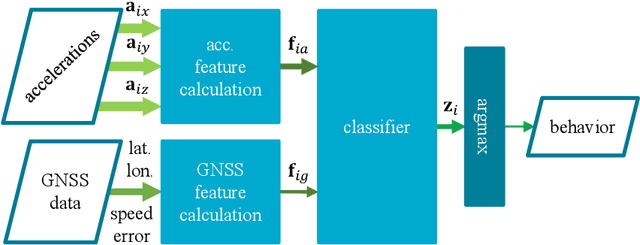Multi-modal Sensor Data Fusion for In-situ Classification of Animal Behavior Using Accelerometry and GNSS Data
Paper and Code
Jun 24, 2022



We examine using data from multiple sensing modes, i.e., accelerometry and global navigation satellite system (GNSS), for classifying animal behavior. We extract three new features from the GNSS data, namely, the distance from the water point, median speed, and median estimated horizontal position error. We consider two approaches for combining the information available from the accelerometry and GNSS data. The first approach is based on concatenating the features extracted from both sensor data and feeding the concatenated feature vector into a multi-layer perceptron (MLP) classifier. The second approach is based on fusing the posterior probabilities predicted by two MLP classifiers each taking the features extracted from the data of one sensor as input. We evaluate the performance of the developed multi-modal animal behavior classification algorithms using two real-world datasets collected via smart cattle collar and ear tags. The leave-one-animal-out cross-validation results show that both approaches improve the classification performance appreciably compared with using the data from only one sensing mode, in particular, for the infrequent but important behaviors of walking and drinking. The algorithms developed based on both approaches require rather small computational and memory resources hence are suitable for implementation on embedded systems of our collar and ear tags. However, the multi-modal animal behavior classification algorithm based on posterior probability fusion is preferable to the one based on feature concatenation as it delivers better classification accuracy, has less computational and memory complexity, is more robust to sensor data failure, and enjoys better modularity.
 Add to Chrome
Add to Chrome Add to Firefox
Add to Firefox Add to Edge
Add to Edge